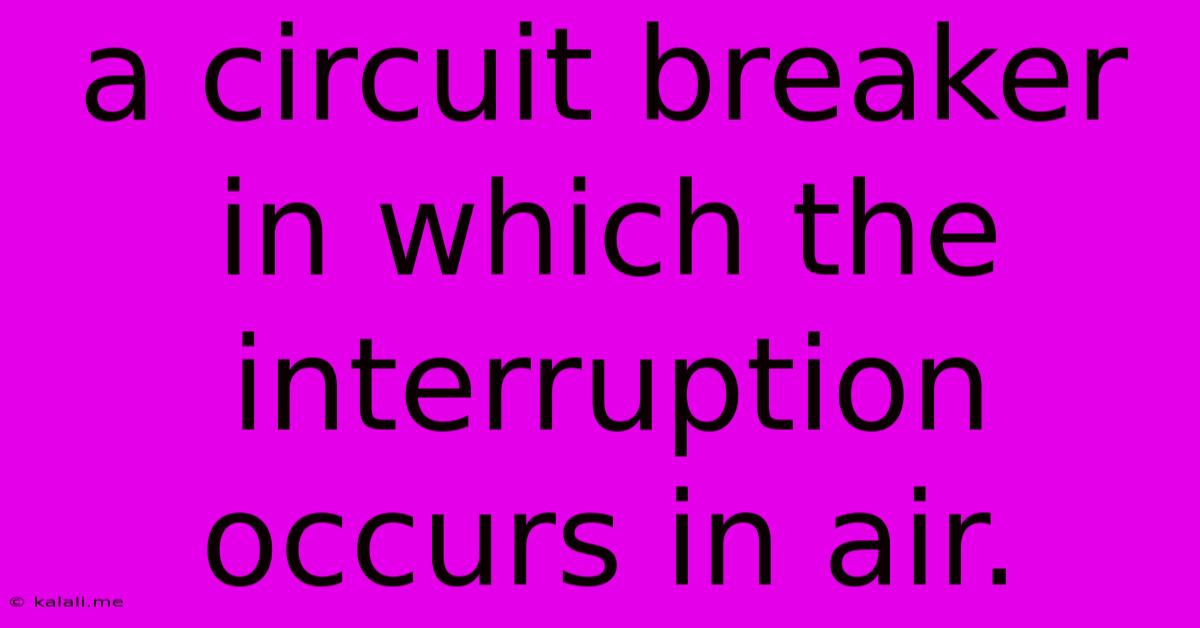A Circuit Breaker In Which The Interruption Occurs In Air.
Kalali
Jun 16, 2025 · 3 min read

Table of Contents
Air Circuit Breakers: A Deep Dive into High-Voltage Switching
Air circuit breakers (ACBs) are electromechanical switching devices designed to interrupt current flow in high-voltage electrical circuits. Unlike their oil or gas-insulated counterparts, ACBs utilize air as the dielectric medium for arc quenching. This makes them a cost-effective solution for many applications, although they come with their own set of advantages and disadvantages. This article will explore the intricacies of air circuit breakers, examining their operation, applications, and limitations.
Understanding the Mechanism of Air Circuit Breakers
ACBs rely on the natural properties of air to extinguish the electric arc produced when interrupting a high current. The process involves several key steps:
-
Current Interruption: When a fault occurs, the ACB's tripping mechanism activates, separating the contacts within the breaker. This creates an electric arc across the contact gap.
-
Arc Formation and Extension: The intense heat generated by the arc ionizes the surrounding air, creating a conductive plasma channel. This arc must be quickly extinguished to prevent damage to the breaker and the electrical system.
-
Arc Quenching: ACBs employ various techniques to quench the arc. Common methods include:
- Magnetic Arc Blow: Utilizing magnetic fields to stretch and cool the arc, thereby increasing its resistance and reducing its current.
- Air Blast: For higher current interruption, compressed air is rapidly injected into the arc zone to forcefully extinguish the plasma. This creates a very fast and efficient arc interruption.
- Air Blast with Interrupter: Combining compressed air with an interrupter, a device that helps cool and extend the arc for quicker interruption.
-
Arc Energy Dissipation: The energy from the arc is dissipated as heat and light into the surrounding air. This process is crucial to prevent reignition and ensure the successful interruption of the circuit.
Applications of Air Circuit Breakers
Air circuit breakers find widespread use in a variety of applications where their unique characteristics prove advantageous:
-
High-Voltage Transmission and Distribution: ACBs are commonly used in substations and transmission lines where high interrupting capacities are required.
-
Industrial Power Systems: Their robustness and reliability make them suitable for industrial settings where power interruptions can have significant consequences.
-
Power Generation: In power plants, ACBs play a crucial role in protecting generators and other critical equipment from damage during faults.
Advantages and Disadvantages of Air Circuit Breakers
Like all circuit breaker technologies, ACBs offer benefits and drawbacks:
Advantages:
- Cost-Effectiveness: Compared to oil or SF6 circuit breakers, ACBs are generally more affordable.
- Relatively Simple Design: Their design is less complex, leading to easier maintenance and repair.
- Environmentally Friendly: ACBs do not utilize potentially hazardous insulating materials like oil or SF6 gas.
- High Interruption Capacity: Modern designs, particularly those using air blast technology, can handle extremely high fault currents.
Disadvantages:
- Higher Maintenance Requirements: While the design is simpler, the contact erosion and potential for contamination can require more frequent maintenance than other types.
- Noise and Arc Flash Concerns: The arc generated during interruption can produce significant noise and a potential arc flash hazard, necessitating appropriate safety measures.
- Large Size and Weight: Compared to other breaker types, ACBs are larger and heavier due to the need for substantial space for arc quenching.
- Limited Application Range: Their effectiveness diminishes in extremely high-voltage applications where other technologies become more efficient and safer.
Conclusion
Air circuit breakers represent a significant technology in the realm of high-voltage switching. While they possess some limitations, their cost-effectiveness, relatively simple design, and environmental friendliness make them a valuable solution for a wide range of applications. Continued advancements in arc quenching techniques and materials science are constantly improving their performance and capabilities. Understanding their strengths and weaknesses is crucial for selecting the appropriate circuit breaker technology for a given electrical system.
Latest Posts
Latest Posts
-
How To Create Clickable Image In Html
Jun 16, 2025
-
What Are The Factors Of 121
Jun 16, 2025
-
What Is A Theme Of The Passage
Jun 16, 2025
-
A Company That Provides Access To The Internet
Jun 16, 2025
-
Which Word Is Closest In Meaning To The Underlined Word
Jun 16, 2025
Related Post
Thank you for visiting our website which covers about A Circuit Breaker In Which The Interruption Occurs In Air. . We hope the information provided has been useful to you. Feel free to contact us if you have any questions or need further assistance. See you next time and don't miss to bookmark.